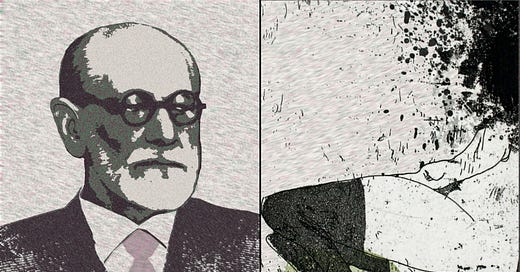A Deep Reading of Why Freud Was Wrong: Sin, Science and Psychoanalysis, by Richard Webster
(Part One · Part Two · Part Three · Part Four · Part Five · Part Six)
(Art by Michelle Horsley)
A great deal of Webster’s criticism of Freud, and the focus of this series thus far, has been on the way Freud’s premises and methodology departed from true scientific inquiry, which has to keep checking in with reality, with the facts, in order to see if it holds up or not. Freud eschewed this method like the plague.
Webster states, a number of times throughout his text, that a big part of Freud’s method for convincing people of his theories had to do with his use of language, how he disguised entirely subjective ruminations as objective science, which, when looked at more closely, are revealed as purest confabulation. Freud used phrases like “we were soon in a position to show” and words like “unquestionably” to create an appearance of authority, and allow armchair speculations to pass for scientific discoveries.
Webster uses the analogy of a bank account in which the balance decreases whenever one draws money out of it, and compared this to Freud’s circumnavigating the regulatory mechanisms of empirical science by setting up his own, private banking system. However big the checks were that Freud was signing, his bank could always print up its own currency to back them up.
The problem in this is obvious: it’s not real money. This is an interesting analogy for a Jewish Messiah; but let’s not linger on that.
Oedipus Wrecks
Webster’s dismantling of Freud’s Oedipus theory was of particular interest to me, because it was central to (at least a couple of chapters in) Prisoner of Infinity. I wouldn’t say I relied upon it, but certain arguments and interpretations of Whitley Strieber’s opus drew heavily on it, making it one Freudian theories I’m inclined to want to defend, or at least keep around. (Another one would be genital organization, which Webster doesn’t really get into.)
Webster is right to point out, however, that the Oedipus theory puts the onus on the child’s psyche and leaves out the behavior of the parents. If a child is developing a desire to have sex with his mother and to kill his father—whatever is supposedly going on there—it surely cannot exist, as Freud claimed, within a void of the child’s psyche, in his biological makeup, independently of specific environmental factors, starting with the parents.
It would seem rather that this is an inversion of the reality that, whatever neurotic patterns are at play in the child’s psyche, they are directly related to the behavior of its parents. “By focusing instead on entirely hypothetical sexual impulses felt by very young children towards their parents, Freud was effectively inverting this pattern” (p. 256). Webster quotes American anthropologist George Devereux, who wrote that Freud’s failure to deal with the role of the parents
is rooted in the adult’s deep-seated need to place all responsibility for the Oedipus complex upon the child and to ignore whenever possible certain parental attitudes which actually stimulate the infant’s Oedipal tendencies (ibid.).
What is more, whatever validity the Oedipus complex has, there’s no evidence to show that a boy’s sexual feelings towards his mother are stronger or more significant between the ages of three and five; nor is there any evidence that these feelings lead to the desire for sex, per se.
Any empirically based psychological theory would, of necessity, depend on close observation and analysis of the immensely complex pattern of child rearing behavior which results. Such a study would include a detailed survey of parents’ own conscious attitudes, beliefs, fantasies, and anxieties about their relationship to their children (p. 257).
Genital Dreams “R” Us
Freud’s dream theory was that all dreams are wish fulfillments. Since this brazen act of reductionism proved too easy to disprove, he added the proviso that dreams are sometimes disguised wish fulfillments. Though not really any more feasible, it made the theory much easier to defend, as Freud did relentlessly, in a Quixotic fashion, in his various case studies.
Of all the passages in Webster’s book up to this point, my mind was truly boggled by the kinds of pretzeled reasoning Freud applied to dreams to get his half-baked theory to rise. When a patient brought a dream that Freud clearly couldn’t reduce to wish-fulfillment, no matter how much he twisted it around, he claimed the patient had confabulated their dream to prove Freud wrong, and therefore, fulfill a wish! Hey presto!
Freud, indeed, seemed to have an almost infinite capacity for tolerating such inconsistencies so long as they led eventually to a confirmation of his own preconceptions. The only conceivable reason that intellectuals have taken seriously his broken logic, his snatched solutions, his constant intellectual self-deception, and the crossword puzzle cleverness which he repeatedly offers in place of real psychological insight, is that he almost invariably uses such modes of argument to scratch at the spot of sex. The imaginative stimulation which results is, it must be suggested, an extremely effective distraction from the poverty of the intellectual operations which lie behind it (p. 269).
As an example of Freud’s Promethean methods of dream analysis, he claimed that women’s hats
“can very often be interpreted with certainty as a genital organ (usually a man’s)”, that the same is true of old coats and ties, and that not only tools and weapons but all forms of luggage and some kinds of relatives (particularly sons, daughters, and sisters), frequently symbolize genitals, as do eyes, noses, ears, and mouths (p. 270).
Seems he forgot to mention cigars?





